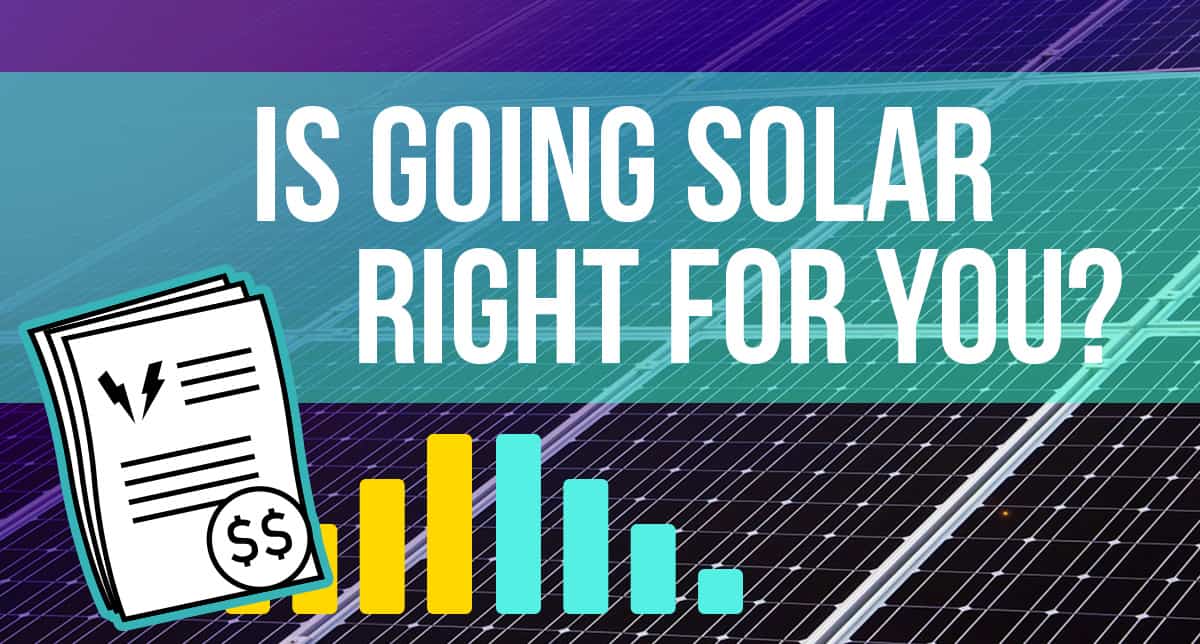Everyone wants to do their duty to help the environment, but it can be difficult to know where to start. Setting up a solar array is quite a commitment and it can come with some hefty costs up front. There’s a lot of hype surrounding new technology from companies like Tesla, and solar providers are eager to pitch solar lease agreements to homeowners. A lot of misinformation swirls around a single unanswered question — is going solar worth it?
How Much Money Can I Save?
Let’s say a home’s solar energy system is set up to generate 850 kWh per month — the consumption of an average Nevadan household in 2017. This would require a 30-panel 7 kW system, taking up around 525 sq. ft. of a well-pitched south-facing roof. It would approximately cost $20,000 before incentives and tax breaks, which would reduce the installation price to $13,000.
That’s $13,000 to minimize the home’s power bill for the next 25 years. The new monthly bill would be NVEnergy’s basic service charge of $12.50, plus 5% in government fees for a total of $13.125/mo.
Considering the average Nevadan’s power bill in 2017 of $102.29, savings equate to $89.17 per month, or $1,069.98 per year. The solar energy system would save $26,749.5 in total over the course of the panels’ 25-year warranty.
The system would pay for itself after 12 years, and would go on to save nearly $14,000 over its lifetime. That’s over a 200% return-on-investment.
So for the average Joe & Jane, setting up a solar system sounds like a nice long-term investment, but with a $13,000 price tag.
Keep in mind that these calculations are using state-wide averages, therefore they may not necessarily reflect your case. This example also assumes 4 hours of direct sunlight per day, which is a simple enough feat compared to other places in the country (looking at you, Seattle). Census data also reported the average Nevadan household size was 2.71 people in 2017. As household size increases, so does monthly power consumption. The good news is that the cost/benefits follow a linear trend, meaning that though the initial cost of a PV system may increase, so do the owner’s annual savings.
Is My Home Viable?
But enough about averages and hypotheticals — how can you determine whether solar is right for you, specifically? To figure that out, you’re going to need to do some legwork.
Find Your Home’s Power Consumption
To see how much money you could save by converting to solar, you first have to evaluate your property’s energy consumption. Measured in kilowatt-hours (kWh), you can find your average monthly consumption on your power bill. (It’s in the top-left corner of this example bill from NVEnergy.)
That’s the target output for your solar power system. The monthly power output dictates how many solar panels (and how much sunlight) you’ll need to power your home.

NV Energy provides a breakdown of your power consumption every month
Use Google’s Project Sunroof
There are many structural variables that can affect the effectiveness of a residential solar energy system: the roof’s pitch, obstacles that block the sun, and the amount of space for solar panels.
Thankfully, online tools exist to do this legwork for you. Google’s Project Sunroof uses satellite imaging to estimate how much sun a property gets per year, then compares current utility payments to potential savings with a solar array. Just enter your address, and Sunroof will help you with the rest.
How Do I Make Money with Solar?
NV Energy and similar power companies offer a system called net metering to consumers who also generate power. Essentially, the power that a consumer buys from a utility grid is tracked separately from the power generated by their system. The consumer is then billed for the difference.
However, if a consumer’s system provides more power to the grid than they use, then the utility provides energy credits for the excess power.
NV Energy has three different options, depending on when a system is registered with the company:
- NMR-G was the original compensation arrangement for solar users, and provided energy credits per kWh generated at a 1:1 value. This is the rider that people talk about being “grandfathered” into, as it only applies to systems set up before December 2015. Energy credits are put toward future payments, and do not provide monetary checks sent to the owner.
- NMR-A riders provide monetary checks at the end of every year, rather than affecting each monthly payment. The energy credit exchange rate is set to decline with each passing year, and according to NV Energy “will likely become lower in value than that of the NMR-G and/or NMR-405 credit.” In addition, this only applies to solar power systems set up between Jan 1, 2016 and Jun 14, 2017.
- NMR-405 is the rider that every owner of a new solar system will receive moving forward. It provides energy credits to owners at descending exchange rates depending on how many people are enrolled in the program. Tier 1 applications are at capacity, so new applicants would receive Tier 2 benefits.

NV Energy’s benefits for NMR-405
NV Energy is very clear about this: “NMR-405 customers will not receive a check at the end of the year, but will continue to accumulate [credits] for future use.”
Basically, just remember that when people talk to you about “selling electricity back to the power company”, they’re usually talking about credits for future bills — don’t expect a monthly check in the mail from NV Energy.

NV Energy’s monthly power bill will show power generated (9) vs power delivered (8)
What’s in a System?

A typical photovoltaic system
Any solar system will be comprised of the same parts; a number of solar panels, a photovoltaic (PV) inverter, a monitoring system, and of course, the utility grid.
1. Solar Panels
There are two options when it comes to solar panels, and each serves a different purpose. Photovoltaic cells convert light into electricity, while thermal cells use sunlight to heat water inside or for a pool system. Most Las Vegans would probably find more mileage out of a photovoltaic system but it is possible to set up both types as long as roof space permits.
2. PV Inverter
A PV inverter converts the direct current (DC) collected by your panels into alternating current (AC) usable by your home appliances. It also connects your panels to your city’s power grid or directly to a localized power network, depending on your needs.
3. Monitoring System
This device provides information to your solar provider; power production, performance diagnostics, etc.
4. Utility Grid
When your system is connected to the grid, the company provides power during times of low solar input, along with the benefits of net metering mentioned earlier.
What about Batteries?
Batteries aren’t required for a PV system to function — net metered clients can pull from the utility grid during the night. However, batteries are good for two things: backup in case of emergencies, and handling Time-of-Use rates. They are expensive though, and it’s up to each user to determine if their benefits are worth the cost, though.
Telsa’s much-lauded Powerwall 2.0 has a maximum capacity of 13.5 kWh, with a list price of $6,300 each and installation costs of around $1,100. Any energy storage system can also get the 30% federal rebate after installation, returning around $2K to the installer. That’s around $5,400 to independently power an average American home for a half-day during an outage. Adding a single Powerwall will require another 5 years for the system to pay it off completely.
You could choose to install a second Powerwall to cover an entire day’s worth of electricity, but that would DOUBLE the price of our example home system and make savings virtually nonexistent.
Also, NV Energy has Time-of-Use (TOU) rate options that can affect net-metered customers. Basically, TOU rates are significantly reduced ($0.06 instead of $0.11 per kWh) except during the region’s peak consumption hours, which are extra expensive ($0.44 instead of $0.11 per kWh).
In Southern Nevada’s case, TOU peak hours are from 1–7pm during summer weekdays.
With a battery like Tesla’s Powerwall, you can set your system to store power during the day and then choose to pull from your battery during peak times. Tesla has a third-party app for users to control their home system from anywhere with Wi-Fi access.

Tesla’s app to manage Powerwall & other devices
Now, TOU rates are not necessarily beneficial for savings: by lowering your rate you’re basically reducing the long-term value of the system. However, some states like California and Hawaii require TOU rates for net-metering clients, and it’s possible that similar policies might creep into Nevada.
In addition, having a power source can benefit users in Nevada because they would get the full value of any stored power, rather than piping it back to the grid at a penalty as per NMR-405’s energy credit values.
Lifespan & Maintenance
Most solar panel modules are very durable, and are built to withstand bad weather. Solar panels have a general lifespan of 25 years before there’s a “significant decline” in power output. Manufacturers offer both an equipment warranty, to certify against manufacturing defects, and a performance warranty, to guarantee that your panels will produce a certain amount of electricity for a period of time.
PV inverters can have a significantly shorter lifespan than your system’s panels. Inverters usually come with a 10-year warranty, but have been known to last 20 years depending on how well the equipment is sheltered from the environment.
Most PV inverters cost around $2K. In our earlier example home, which cost $13K, replacing the PV inverter would add on an extra two years before the system pays for itself. This would move the payoff date of the system from 12 to 14 years.
Financing — Should I Buy or Lease?
Now, as mentioned before, $13K is quite a bit to shell out in one purchase. Solar providers offer alternative payment options through a Power Purchase Agreement (PPA) or Solar Lease, requiring little-to-no money up front.
But here’s the bottom line: if you’re not buying your system outright, you’ll end up reallocating the funds for your existing power bill into a different monthly payment. This can be attractive to people who want to immediately reduce their power bill with little capital up front, but the dividends here in Nevada will be less dramatic than a system that’s bought outright.
Solar providers say you can generally expect to reduce your monthly payment through a PPA or Solar Lease by 10–30%, but that number can vary depending on the size of your system and the company that sets up your system.
Let’s go back to our example house. Even if the home’s solar system reduced the monthly power bill to its minimum, its owner would still have a monthly payment of about $100-$150 for 10 years. They’d spend about $12,000-$18,000 over the course of 10 years. At the end of the term, they’d end up owning the panels (if they chose to buy). By leasing, the overall cost could be more than an outright purchase, but wouldn’t require a lot of cash up front.
Overall, it’s ideal to purchase a system (or at least be an owner even if it’s through financing) because of the incentives available to owners. However, leasing is still a good option if you need a no-money-down approach and slightly lower utility rates.
Project Sunroof provides a personalized calculator that breaks down potential savings (or costs) of choosing a lease or loan versus purchasing the system up front, including federal & local incentives.

After reading your address, Sunroof gives you personalized financial projections based on satellite imagery.
So what’s the Verdict?
Residential solar definitely has a place here in Southern Nevada, and plenty of resources make it simple to set up a sustainable energy system. However, you’ll want to act soon, since there are some changes coming to federal tax incentives by the end of the year.

The ITC extension is set to decline with each passing year
Congress extended the investment tax credit (ITC) Federal tax credit from its initially projected end date in 2016 to 2022. The tax credit allows you to deduct up to 30% of the cost of installing a renewable energy system from your federal taxes.
However, this credit is set to drop to 26% in 2020, then to 22% in 2021, and finally to a flat rate of 10% for commercial systems in 2022. With each reduction, the projected payoff date of a solar energy system increases significantly.
If you notice that your property gets extra sun, and you find yourself trying to reduce your utility bill, consider whether a solar energy system would be right for you. Whether you lease or buy, you could be doing yourself — and the environment — a favor.





